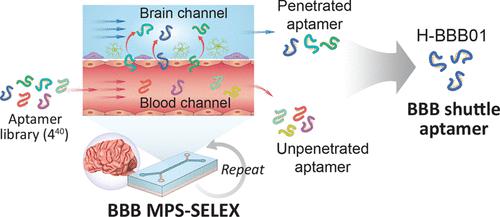Our official English website, www.x-mol.net, welcomes your
feedback! (Note: you will need to create a separate account there.)
Aptamer Nanoconstructs Crossing Human Blood–Brain Barrier Discovered via Microphysiological System-Based SELEX Technology
ACS Nano ( IF 15.8 ) Pub Date : 2023-04-17 , DOI: 10.1021/acsnano.2c11675 Jeong-Won Choi 1 , Minwook Seo 1 , Kyunghwan Kim 2 , A-Ru Kim 3 , Hakmin Lee 3 , Hyung-Seok Kim 4 , Chun Gwon Park 5, 6 , Seung Woo Cho 1 , Joo H Kang 1 , Jinmyoung Joo 1 , Tae-Eun Park 1
ACS Nano ( IF 15.8 ) Pub Date : 2023-04-17 , DOI: 10.1021/acsnano.2c11675 Jeong-Won Choi 1 , Minwook Seo 1 , Kyunghwan Kim 2 , A-Ru Kim 3 , Hakmin Lee 3 , Hyung-Seok Kim 4 , Chun Gwon Park 5, 6 , Seung Woo Cho 1 , Joo H Kang 1 , Jinmyoung Joo 1 , Tae-Eun Park 1
Affiliation

|
Blood–brain barrier (BBB) remains one of the critical challenges in developing neurological therapeutics. Short single-stranded DNA/RNA nucleotides forming a three-dimensional structure, called aptamers, have received increasing attention as BBB shuttles for efficient brain drug delivery owing to their practical advantages over Trojan horse antibodies or peptides. Aptamers are typically obtained by combinatorial chemical technology, termed Systemic Evolution of Ligands by EXponential Enrichment (SELEX), against purified targets, living cells, or animal models. However, identifying reliable BBB-penetrating aptamers that perform efficiently under human physiological conditions has been challenging because of the poor physiological relevance in the conventional SELEX process. Here, we report a human BBB shuttle aptamer (hBS) identified using a human microphysiological system (MPS)-based SELEX (MPS-SELEX) method. A two-channel MPS lined with human brain microvascular endothelial cells (BMECs) interfaced with astrocytes and pericytes, recapitulating high-level barrier function of in vivo BBB, was exploited as a screening platform. The MPS-SELEX procedure enabled robust function-based screening of the hBS candidates, which was not achievable in traditional in vitro BBB models. The identified aptamer (hBS01) through five-round of MPS-SELEX exhibited high capability to transport protein cargoes across the human BBB via clathrin-mediated endocytosis and enhanced uptake efficiency in BMECs and brain cells. The enhanced targeting specificity of hBS01 was further validated both in vitro and in vivo, confirming its powerful brain accumulation efficiency. These findings demonstrate that MPS-SELEX has potential in the discovery of aptamers with high target specificity that can be widely utilized to boost the development of drug delivery strategies.
中文翻译:

通过基于微生理系统的 SELEX 技术发现穿过人类血脑屏障的适体纳米结构
血脑屏障 (BBB) 仍然是开发神经疗法的关键挑战之一。形成三维结构的短单链 DNA/RNA 核苷酸,称为适配体,由于其优于特洛伊木马抗体或肽的实用优势,作为 BBB 穿梭车以有效地输送脑部药物而受到越来越多的关注。适体通常通过组合化学技术获得,称为指数富集配体系统进化 (SELEX),针对纯化的靶标、活细胞或动物模型。然而,由于传统 SELEX 过程中的生理相关性较差,识别在人体生理条件下有效执行的可靠的 BBB 穿透适体一直具有挑战性。这里,我们报告了使用基于人类微生理系统 (MPS) 的 SELEX (MPS-SELEX) 方法识别的人类 BBB 穿梭适体 (hBS)。一种双通道 MPS,内衬人脑微血管内皮细胞 (BMEC),与星形胶质细胞和周细胞相互作用,重现了高水平屏障功能体内BBB,被用作筛选平台。MPS-SELEX 程序能够对 hBS 候选者进行基于功能的稳健筛选,这在传统的体外BBB 模型中是无法实现的。通过五轮 MPS-SELEX 鉴定的适体 (hBS01) 表现出通过网格蛋白介导的内吞作用将蛋白质货物运输到人类 BBB 的能力,并提高了 BMEC 和脑细胞的摄取效率。hBS01 增强的靶向特异性在体外和体内得到进一步验证,证实了其强大的大脑积累效率。这些发现表明 MPS-SELEX 具有发现具有高靶标特异性的适体的潜力,这些适体可广泛用于促进药物递送策略的发展。
更新日期:2023-04-17
中文翻译:

通过基于微生理系统的 SELEX 技术发现穿过人类血脑屏障的适体纳米结构
血脑屏障 (BBB) 仍然是开发神经疗法的关键挑战之一。形成三维结构的短单链 DNA/RNA 核苷酸,称为适配体,由于其优于特洛伊木马抗体或肽的实用优势,作为 BBB 穿梭车以有效地输送脑部药物而受到越来越多的关注。适体通常通过组合化学技术获得,称为指数富集配体系统进化 (SELEX),针对纯化的靶标、活细胞或动物模型。然而,由于传统 SELEX 过程中的生理相关性较差,识别在人体生理条件下有效执行的可靠的 BBB 穿透适体一直具有挑战性。这里,我们报告了使用基于人类微生理系统 (MPS) 的 SELEX (MPS-SELEX) 方法识别的人类 BBB 穿梭适体 (hBS)。一种双通道 MPS,内衬人脑微血管内皮细胞 (BMEC),与星形胶质细胞和周细胞相互作用,重现了高水平屏障功能体内BBB,被用作筛选平台。MPS-SELEX 程序能够对 hBS 候选者进行基于功能的稳健筛选,这在传统的体外BBB 模型中是无法实现的。通过五轮 MPS-SELEX 鉴定的适体 (hBS01) 表现出通过网格蛋白介导的内吞作用将蛋白质货物运输到人类 BBB 的能力,并提高了 BMEC 和脑细胞的摄取效率。hBS01 增强的靶向特异性在体外和体内得到进一步验证,证实了其强大的大脑积累效率。这些发现表明 MPS-SELEX 具有发现具有高靶标特异性的适体的潜力,这些适体可广泛用于促进药物递送策略的发展。













































 京公网安备 11010802027423号
京公网安备 11010802027423号